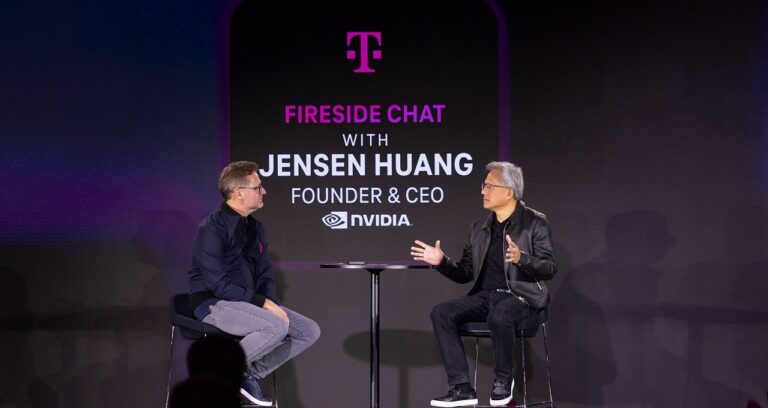NVIDIA founder and CEO Jensen Huang made a surprise appearance at T-Mobile’s Capital Markets Day to share his bold vision for the future of the communications industry.
“We’ve combined signal processing with AI,” Huang declared in a discussion with T-Mobile CEO Mike Siebert before a panel of press, analysts and investors. “This will be a huge new growth opportunity for the communications industry.”
Huang’s remarks came alongside NVIDIA’s announcement of its groundbreaking AI Aerial platform, which promises to reshape wireless networks by integrating AI and radio access networks (AI-RAN).
The platform is designed to optimize network performance, efficiency and new revenue potential, such as AI Compute as a Service, maximizing return on assets during periods when network infrastructure is underutilized.
During the conversation, Huang emphasized the importance of AI in shaping the future of communications, particularly highlighting the role of AI-RAN in optimizing and enhancing network performance.
Integrating wireless computing and AI computing into one architecture will enable companies to apply AI models to optimize signal quality across different environments, Huang explained.
He emphasized that this convergence will lead to improved network efficiency and new growth opportunities for the telecommunications industry.
“We can teach these AI models how to optimize signal quality across hundreds of thousands of virtual cities,” Huang said.
AI-RAN aligns with NVIDIA’s broader vision of making AI an integral part of network infrastructure, enabling communications providers to capture new revenue streams and deliver enhanced experiences through generative AI, robotics and autonomous technologies.
Huang highlighted the synergies between NVIDIA and T-Mobile, particularly the companies’ collaboration as co-authors of the transformation in the newly announced AI-RAN Innovation Center. Developed in collaboration with T-Mobile, Ericsson and Nokia, the AI-RAN Innovation Center will accelerate the commercialization of AI-RAN technology.
Every radio operates in a unique and ever-changing global environment. Deep reinforcement learning algorithms embedded in radio signal processing use AI to simplify complex calculations and help deliver a customer-centric network experience.
Sievert emphasized that virtualizing the RAN to the cloud will create new business opportunities. He explained that AI workloads will increasingly require computing power located closer to customers, taking advantage of underutilized network resources.
Huang also highlighted the important role AI plays in making networks more energy efficient, underscoring the need for sustainable technology as demand for data and connectivity grows.
“We need to leverage AI to reduce energy consumption,” Huang said. “Anything we accelerate, anything we teach our AI models, will lead to greater energy efficiency.”
As Huang explained, NVIDIA maximizes energy efficiency by simulating AI models in a virtual environment with accurate physics and then emulating it in the real world. This approach is the foundation of the NVIDIA AI Aerial platform suite for designing, training and deploying AI-driven cellular networks for AI.
NVIDIA AI Aerial now supports a growing ecosystem of partners, and this collaboration marks a milestone in the communications industry’s journey toward an AI-powered future.

